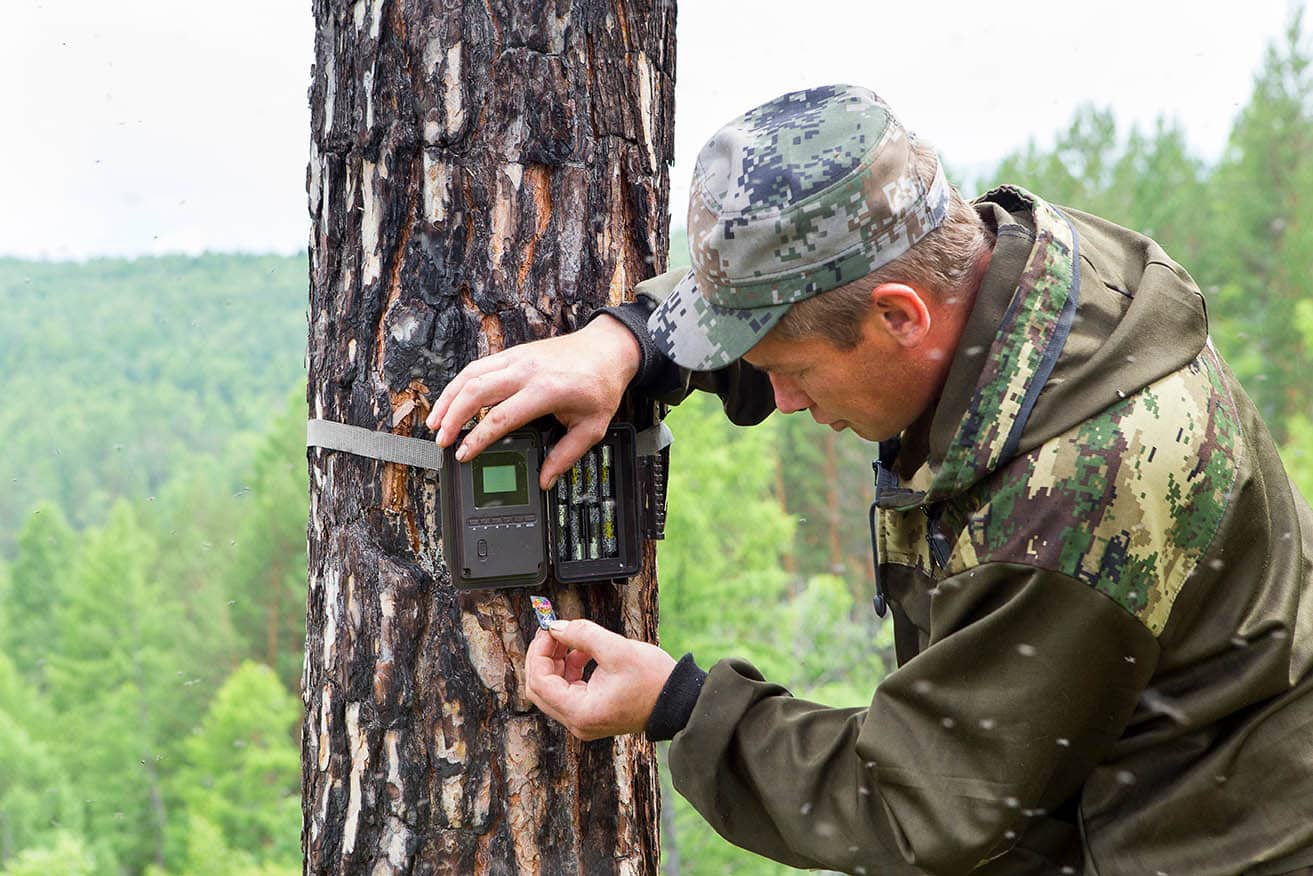Trail Cam Photos That Will Never Be Recorded Again
Last Updated on

It can exist incredibly frustrating to become out to your trail camera after it'south been up for a while but to discover that it hasn't taken whatsoever pictures, it stopped taking pictures afterward a curt period of time, or is taking pictures that don't evidence y'all what you want to see.
In this article, we're going to get over nine of the most common issues that forestall trail cameras from taking pictures entirely. And so we'll briefly go over what issues can cause bad pictures.
Nigh of the time, if your trail camera is not taking pictures, the problem volition fall into one of iii categories: an event with the SD card, an event with the battery, or an outcome with camera placement or settings. Luckily, all of these issues are easy to fix, then before you go on the line with customer service, make sure you've gone through these possible problems and resolved them.

Issues With the SD Card
There are a few things yous can check with your SD card to see if it may be the culprit.
i. Wrong Type of SD Card
For a trail camera, you are likely using an SD card with at least 32 GB of capacity, and perhaps much more that. The trouble is that SD cards with a capacity of more than than 32 GB are SDXC cards, while cards with 32 GB or less are SDHC cards. A lot of cameras can use either type of bill of fare, but some are limited to SDHC, and so if you've put a college capacity bill of fare in, it won't piece of work.
Yous can cheque the documentation for your camera and it should specify what types of cards information technology is uniform with.
If you've verified that the type of card you're using is correct, then the next stride would be formatting the carte du jour.

Image Credit: EsaRiutta, Pixabay
2. SD Menu Needs to Be Formatted
Brand-new SD cards ofttimes demand to be formatted before they tin can be used. You lot may accept a trail camera that tin can perform this operation on the card in one case it'southward inserted, only information technology's more than likely that you lot'll demand to do this with your estimator before putting it in the camera. Fifty-fifty cards that have been working fine sometimes need to exist formatted.
Formatting is essentially just wiping the carte clean of any previous data or file arrangement that was on it previously and replacing information technology with a new arrangement. To format a card, simply place it in your estimator and when it pops upward on your desktop or explorer window, correct-click and select "format".
Equally long as you are using the same reckoner to format the carte du jour every bit you lot will to copy the pictures over once they're taken, then yous tin can probably stick with the default settings. If the card is more than 32 GB in capacity, you tin can choose "exFAT" every bit the file system for maximum compatibility. For 32 GB or lower, FAT32 or FAT16 are good choices.
3. SD Card Is Locked
This may seem like such a simple thing, but it tin can be incredibly aggravating to discover that the SD carte du jour yous thought had been recording this whole time was really locked and unable to tape. All SD cards have a little slider on the side that can click up and downwards to either lock or unlock the card. The locking mechanism is designed to forestall the data on the card from being accidentally overwritten.
Information technology is common for people to lock a card afterwards recording something important to protect the data inside until they are able to copy the files onto their computer. A locked SD card will not let any new data to be written to information technology, so fifty-fifty if the photographic camera is taking images, it can't save them anywhere.
This is an easy fix. Simply slide the piffling plastic piece to the picture of the open padlock and you're good to go. While frustrating, this is actually the easiest and fastest problem to resolve.
4. SD Menu Is Damaged
SD cards are pretty tough fiddling devices, and then unless your card has been dropped from high up onto precipitous rocks or been hit difficult with something, it should concluding a long time. SD cards have been known to work fine even after being put through the wash riding in a pants pocket. Equally an SD menu gets older, you will almost probable offset to notice that some of the pictures have glitches or are corrupted.
This should happen long before the card fails completely, then you lot should accept some warning that the bill of fare is on the manner out before y'all lose an unabridged batch of photos, but information technology's certainly possible that the reason the photographic camera isn't taking photos is that the SD bill of fare is damaged.
Before you use your card for target practice, though, you lot should check a few other potential causes first.

Battery Problems
5. Batteries Are Dead
This is probably the first thing you tried, but only in example yous haven't nevertheless, you should admittedly try swapping out the batteries, even if the ones currently in the camera are new. Expressionless batteries are easy enough to understand, only at that place are a few considerations with batteries specifically with trail cameras that may not be as obvious.
6. Corrosion Is Preventing Proficient Contact

Image Credit: Didgeman, Pixabay
Being outdoors in the hot sun, wet rain, and common cold snowfall volition cause even the almost rugged trail camera to bear witness signs of wearable and tear. 1 of those signs is battery corrosion. If yous notice a white, powdery substance in the battery compartment, especially near the contact points, at that place is a chance that the corrosion is interfering with the proper transmission of power.
You can scrape the corrosion off and try putting new batteries in to see if that resolves the issue.
7. Alkaline vs. Lithium Batteries
Alkaline batteries may be cheaper (sometimes a lot cheaper), merely lithium batteries last much longer, and when your trail camera may need to run for a week, a month, or even longer without new batteries, using lithium instead of alkaline metal can make a great bargain of sense. Information technology can also prevent you from losing out on valuable photos that assist you track wild animals on your holding.

Settings or Placement Issues
Even if everything within the camera is working perfectly, there may be problems with the camera's settings or where the photographic camera is placed that are preventing the camera from taking pictures. Oftentimes, if this is the case, you'll likely have some photos, just not of what you were intending to capture. However, sometimes this can result in getting no pictures at all.
eight. Settings Issues
Most trail cameras have more one manner, and if you switch out of motion-activated mode, the camera won't notice motility and won't have any pictures. A lot of cameras have a time-lapse mode, a video mode, and even a manual mode. The camera won't work as expected if information technology's in any of these modes unless that'south what you desire the camera to do.
Some cameras also allow yous to control things similar the flash for night-time shooting and which sensors the photographic camera uses to detect motion. Setting these incorrectly can crusade the photographic camera to fail to take pictures, or to take them besides slowly to capture what you want.

9. Placement Problems
Manufacturers are notorious for advertisement the "theoretical" maximum range for the sensor and flash, and so if you've placed your camera far enough away from the trail to be at the edge of that advertised range, and so that might exist why it'southward not taking pictures.
Another effect can come if you place the camera as well loftier and don't angle it down enough (or angle it downwards too much). Placing the camera high tin can be a good mode to preclude theft and cover a wider area, merely it likewise increases the distance from your camera to the target area, so it will need to exist closer than it would if it were at eye level.
There are plenty of other issues that can come from where the camera is placed, only most of them will atomic number 82 to bad pictures being taken instead of no pictures at all.

Trail Camera Taking Bad Pictures
Then, if you've got your camera working merely now it's taking pictures that are unusable for one reason or some other, here are a few reasons why that might be the case.
Photographic camera Shutter Speed and Other Settings
Ideally, you'd desire your camera to snap a crystal-articulate picture the instant that it detects motion, and proceed taking pictures as long as it continues to detect that movement. However, once a sensor detects motion, it has to plough on the bodily camera, focus the lens, then snap a picture. This process tin have a few seconds depending on your photographic camera, and if it's too slow, yous'll miss out on the good shots and end upwardly with something sub-par.
If your camera allows you to manually conform the settings, you'll want to effort for the fastest shutter speed you can get while still having a vivid enough picture. If you lot're not a photographer, you can just let the camera fix shutter speed automatically.

Image Credit: Jesada Sabai, Shutterstock
The trail camera needs to exist able to take clear pictures in vivid daylight and total darkness with the help of a flash of some kind, so continue with circumspection if you are trying to tinker with settings that affect the image quality. Any changes you make that improve the photos in the daytime will likely worsen the photos at dark and vice versa.
Placement Problems That Tin can Atomic number 82 to Bad Photos
Having the photographic camera placed too far abroad from the target area is the number ane culprit when you lot end up with a hundred photos of the aforementioned empty scene, then make certain that your camera is well inside the advertised range of the sensor and flash. Having the camera pointed at an angle where the lens can take hold of the glare of the dominicus can besides ruin photos.
Sometimes this is obvious, but the furnishings can too exist more subtle and just brand the image look soft or blurry.

Final Thoughts
If none of these solutions are able resolve your problem with your trail camera, information technology may exist worth giving the customer service section a telephone call and seeing about the warranty on your camera. If it'southward not the batteries, the SD card, or the placement, then the only other likely option left is the photographic camera itself. Best of luck, and happy trails!
Featured Image: SERGEI PRIMAKOV, Shutterstock
Table of Contents
- Issues With the SD Carte du jour
- 1. Wrong Type of SD Card
- 2. SD Card Needs to Be Formatted
- 3. SD Carte Is Locked
- 4. SD Menu Is Damaged
- Bombardment Bug
- v. Batteries Are Dead
- six. Corrosion Is Preventing Good Contact
- 7. Element of group i vs. Lithium Batteries
- Settings or Placement Problems
- 8. Settings Issues
- 9. Placement Issues
- Trail Photographic camera Taking Bad Pictures
- Camera Shutter Speed and Other Settings
- Placement Issues That Can Lead to Bad Photos
- Terminal Thoughts
Source: https://opticsmag.com/trail-camera-not-taking-picture-fixes/
0 Response to "Trail Cam Photos That Will Never Be Recorded Again"
Post a Comment